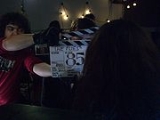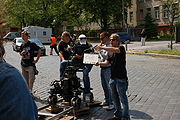
Clapperboard
Encyclopedia



Filmmaking
Filmmaking is the process of making a film, from an initial story, idea, or commission, through scriptwriting, casting, shooting, directing, editing, and screening the finished product before an audience that may result in a theatrical release or television program...
and video production
Video production
Video production is videography, the process of capturing moving images on electronic media even streaming media. The term includes methods of production and post-production...
to assist in the synchronizing of picture and sound, and to designate and mark particular scene
Scene (fiction)
In fiction, a scene is a unit of drama. A sequel is what follows; an aftermath. Together, scene and sequel provide the building blocks of plot for short stories, novels, and other forms of fiction.-Characteristics of a scene:...
s and take
Take
A take is a single continuous recorded performance. The term is used in film and music to denote and track the stages of production.-Film:In cinematography, a take refers to each filmed "version" of a particular shot or "setup"...
s recorded during a production. The sharp "clap" noise that the clapperboard makes can be identified easily on the audio track, and the shutting of the clapstick can be identified easily on the separate visual track. The two tracks can then be precisely synchronised by matching the sound and movement. Other names for the clapperboard include clapper, clapboard, slate, slate board, sync slate, time slate, sticks, board, and marker.
When a movie's sound and picture are out of synchronization, this is known as lip flap.
Overview
The clapperboard or clapboard slate is the combination of the chalkboard slate that held information identifying the next scene and the clapstick which was used to align sound and picture. In the early days of film, one person would hold a slate for the camera with the scene information, while another clapped two hinged sticks together in front of the camera. The combination of the two into one unit made it much easier for just one person to handle both jobs.Traditional clapperboards used to consist of a wooden slate and a hinged clapstick attached to the top of the slate. However, modern clapperboards now generally use a pair of wooden sticks atop whiteboard
Whiteboard
A whiteboard is a name for any glossy, usually white surface for nonpermanent markings. Whiteboards are analogous to chalkboards, allowing rapid marking and erasing of markings on their surface...
or translucent acrylic glass
Acrylic glass
Poly is a transparent thermoplastic, often used as a light or shatter-resistant alternative to glass. It is sometimes called acrylic glass. Chemically, it is the synthetic polymer of methyl methacrylate...
slates which do not require additional lighting from the camera side to be legible. Some versions are also backlit. Smart slates or digislates are electronic SMPTE time code
SMPTE time code
SMPTE timecode is a set of cooperating standards to label individual frames of video or film with a time code defined by the Society of Motion Picture and Television Engineers in the SMPTE 12M specification...
versions with LED
Light-emitting diode
A light-emitting diode is a semiconductor light source. LEDs are used as indicator lamps in many devices and are increasingly used for other lighting...
numbers. The clapsticks traditionally have diagonally interleaved lines of black and white to ensure a clear visual of the clap in almost any lighting conditions, but in recent years sticks with calibrated color stripes have also become available. In some productions, particularly those created in the digital
Digital
A digital system is a data technology that uses discrete values. By contrast, non-digital systems use a continuous range of values to represent information...
domain, electronically superimposed versions of a clapperboard have supplanted the real thing.
In use, the details of the next take
Take
A take is a single continuous recorded performance. The term is used in film and music to denote and track the stages of production.-Film:In cinematography, a take refers to each filmed "version" of a particular shot or "setup"...
are written on the slate of the clapperboard.
This typically includes the date, the production title, the name of the director
Film director
A film director is a person who directs the actors and film crew in filmmaking. They control a film's artistic and dramatic nathan roach, while guiding the technical crew and actors.-Responsibilities:...
, the name of the director of photography (DP) and the scene information - which follows two popular systems: American - scene
Scene (fiction)
In fiction, a scene is a unit of drama. A sequel is what follows; an aftermath. Together, scene and sequel provide the building blocks of plot for short stories, novels, and other forms of fiction.-Characteristics of a scene:...
number, camera angle
Camera angle
The camera angle marks the specific location at which a camera is placed to take a shot. A scene may be shot from several camera angles. This will give different experience and sometimes emotion. the different camera angles will have different effects on the viewer and how they perceive the scene...
and take
Take
A take is a single continuous recorded performance. The term is used in film and music to denote and track the stages of production.-Film:In cinematography, a take refers to each filmed "version" of a particular shot or "setup"...
number; e.g. scene 24, C, take 3; European - slate number, take
Take
A take is a single continuous recorded performance. The term is used in film and music to denote and track the stages of production.-Film:In cinematography, a take refers to each filmed "version" of a particular shot or "setup"...
number (with the letter of the camera shooting the slate if using multiple-camera setup
Multiple-camera setup
The multiple-camera setup, multiple-camera mode of production, or multicam is a method of filmmaking and video production. Several cameras—either film or professional video cameras—are employed on the set and simultaneously record or broadcast a scene...
); e.g. slate 256, take 3C. Often the European system will also include the scene number; however, a separate continuity sheet that maps the slate number to the scene number, camera angle and take number may be used if the scene number is not included on the slate. This is generally not as great a concern with short films, however. The clapper loader
Clapper loader
A clapper loader, or second assistant camera is part of a film crew, whose main functions are that of loading the raw film stock into camera magazines, operating the clapperboard at the beginning of each take, marking the actors as necessary, and maintaining all records and paperwork for the...
(or 2nd AC) is generally responsible for the maintenance and operation of the clapperboard, while the script supervisor
Script supervisor
A script supervisor is a member of a film crew responsible for maintaining the motion picture's internal continuity and for recording the production unit's daily progress in shooting the film's screenplay...
is responsible for determining which system will be used and what numbers a given take should have. While these are usually fairly obvious once a system has been agreed upon, the script supervisor is usually considered the final arbiter in the event of an unclear situation.
A verbal identification of the numbers, known either as "voice slate" or "announcement", occurs after sound has reached speed. At the same time or shortly thereafter, the camera will start running, and the clapperboard is then filmed briefly at the start of the take and the clapsticks are clapped sharply as soon as the camera has reached sync speed. Specific procedures vary depending on the nature of the production (documentary, television, feature, commercial, etc.) and the dominant camera assisting conventions of the region; therefore it is not possible to describe a definitive practice aside from the general principles.
Sometimes a tail slate or end slate is filmed at the end of a take, during which the clapperboard is held upside-down. This is done when the clapperboard wasn't captured or was missing at the start of the take.
The clapper (two sticks hinged together) may have been invented by Frank Thring (father of actor Frank Thring
Frank Thring
Frank William Thring was an Australian character actor.-Early life:Thring was born in Melbourne and educated at the Melbourne Grammar School. His father, Frank W. Thring, was the head of Efftee Studios, in Melbourne, in the 1920s, and is said to be the inventor of the clapperboard...
), who was head of Efftee Studios
Efftee Studios
Efftee Studios was established by F.W. Thring in 1930.In 1931 the first commercially viable Australian made sound feature film, Diggers, was produced by Efftee Films in Melbourne using optical sound equipment imported from the USA.Efftee was also the first licensee of Melbourne radio station 3XY...
in 1920s Melbourne
Melbourne
Melbourne is the capital and most populous city in the state of Victoria, and the second most populous city in Australia. The Melbourne City Centre is the hub of the greater metropolitan area and the Census statistical division—of which "Melbourne" is the common name. As of June 2009, the greater...
, Australia
Australia
Australia , officially the Commonwealth of Australia, is a country in the Southern Hemisphere comprising the mainland of the Australian continent, the island of Tasmania, and numerous smaller islands in the Indian and Pacific Oceans. It is the world's sixth-largest country by total area...
.
The current digital
Digital
A digital system is a data technology that uses discrete values. By contrast, non-digital systems use a continuous range of values to represent information...
slate was invented by Matthew L. Davies, holder of US patent number 6831729.

